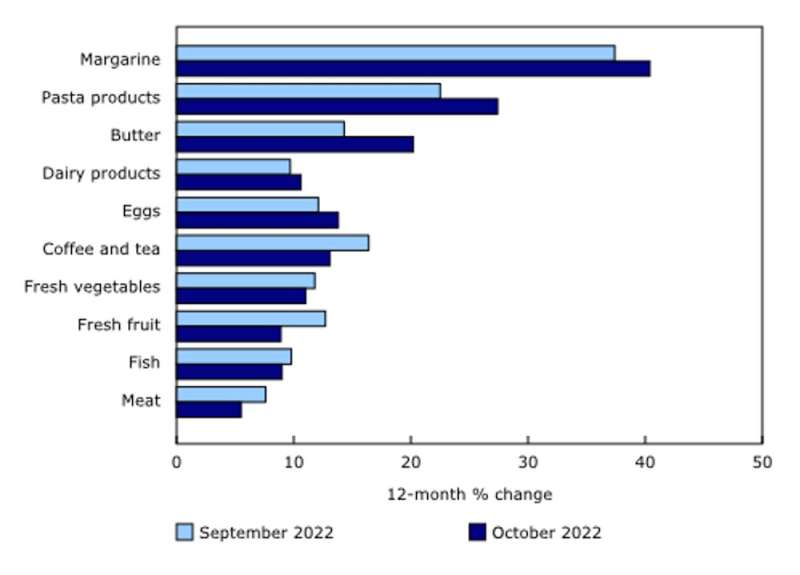naproxen 500 mg for leg pain


Food for thought: rising grocery prices affect food choices and nutrition, and ultimately health, and even the health care system.
As a result of inflation, the cost of food continues to soar, with data from Statistics Canada reporting the latest price changes of foods purchased from groceries stores and restaurants.
In September, Canada experienced its largest yearly increase in foods purchased from grocery stores or restaurants (10.3%). Prices for food rose slightly less in October (10%), but remain elevated, with November’s increase coming in at 6.8%.
In response to this rapid inflation, st johns family medicine springfield mo many Canadians took to social media, particularly TikTok, to share how much grocery shopping is costing and what they are getting for their money.
Canada’s recent lettuce shortage has resulted in price hikes for romaine and iceberg lettuce, with many grocery stores posting signs about the shortage and imposing purchase quantity limits, while restaurants have modified their offerings and altered their menus.
Why are food prices so high?
The COVID-19 pandemic and other global events continue to have worldwide consequences for health and the economy, with food prices being no exception.
Prices are driven up in several ways, including supply chain issues (things like processing, packaging and transportation), changes in consumer spending patterns, and previously mandated business closures forcing the redistribution of foods from restaurants to stores, as well as unfavorable growing weather conditions (things like heat waves, extreme rain/flooding, droughts and freezing).
As health behavior researchers, we believe that many Canadians will undoubtedly feel the additional financial pressure at the checkout line, and many will eat less nutritious and cheaper food options.
In Ottawa, the cost of eating nutritious food for a single person was estimated at $392 per month, based on data collected from May to June 2022. For a family of four, the cost jumps to $1,088 per month.
Undoubtedly, low-income and fixed-income households will feel the biggest pinch (especially in one-person or single-parent households) and the short- and long-term health impact could add to our crippling health care system.
How do rising food costs impact your health?
With the rising cost of food, many Canadians are experiencing insecure or limited access to food. This can have various effects on health, such as a decrease in mental health, increased risk of diabetes, higher rates of autoimmune and infectious diseases, and injuries.
Research has shown that increased household food insecurity is strongly associated with greater strain on the health care system, with greater emergency room visits, longer hospital stays, more same-day surgeries, more reliance on physician services and home care services, and higher prescription drug use.
Older adults may also have health conditions with specific dietary requirements. With the increase in food prices, meeting these specific dietary needs may not be possible and can lead to additional health complications.
Furthermore, the higher cost of food is putting strain on food banks and school food programs, like the Ontario Student Nutrition Program. School food programs provide support to children by helping ensure their stomachs are full while promoting healthful eating practices.
School food programs have been shown to be beneficial for better academic outcomes and overall health in the short term, and food choices and behaviors in children are likely to continue into adulthood, making childhood an essential time to have access to healthy foods. Suboptimal nutrition during this stage also may interfere with optimal growth and development.
What can you do to save money?
One of the most expensive things about food is food waste. According to Second Harvest, Canada’s largest food rescue organization, the annual cost of avoidable food loss and waste in Canada was $1,766 per household.
Making a meal plan for the week, with a shopping list before you go to the grocery store, is a great way to buy only what you need and ensure you use up what you’ve purchased. If you are only going to use half the produce for one meal, make sure you have a second recipe for later in the week to use it up.
There are several online applications, such as Flipp or Reebee, that can also help you shop sales or use coupons. Many food outlets allow price matching with other stores. Using loyalty program points is another option that can help pay for groceries. If you are a student or older adult, your local grocery store or retail drug store may offer discounts for shopping on a specific day of the week.
Lastly, eating with other people is not only associated with better diet quality and psychosocial outcomes, but may also reduce food costs, as families are only making one meal for all to enjoy.
Provided by
The Conversation
This article is republished from The Conversation under a Creative Commons license. Read the original article.
Source: Read Full Article